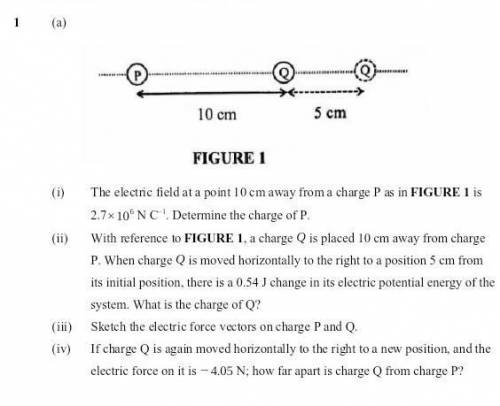
Physics, 24.01.2022 07:00 lucyamine0
(i) The electric field at a point 10 cm away from a charge P as in FIGURE 1 is 2.7 x 10 NC-1. Determine the charge of P.
(ii) a charge Q is placed 10 cm away from charge P. When charge Q is moved horizontally to the right to a position 5 cm from its initial position, there is a 0.54 J change in its electric potential energy of the system. What is the charge of Q?
(iii) Sketch the electric force vectors on charge P and Q.
(iv) If charge Q is again moved horizontally to the right to a new position, and the electric force on it is -4.05 N; how far apart is charge Q from charge P?
(b) Two oppositely charged parallel plates are held 2 mm apart. A 4 x 107 of work is needed to move a 2 C point charge from one plate to the other. Calculate the electric field between the plates.


Answers: 1


Other questions on the subject: Physics

Physics, 21.06.2019 21:40, 2003loganreed
Avery hard rubber ball (m = 0.5 kg) is falling vertically at 4 m/s just before it bounces on the floor. the ball rebounds back at essentially the same speed. if the collision with the floor lasts 0.05 s, what is the average force exerted by the floor on the ball?
Answers: 3

Physics, 21.06.2019 21:50, jferdi2005
When applying kirchhoff's rules, one of the essential steps is to mark each resistor with plus and minus signs to label how the electric potential changes from one end of the resistor to the other. the circuit in the drawing contains four resistors, each marked with the associated plus and minus signs. however, one resistor is marked incorrectly. which one is it?
Answers: 1


Physics, 22.06.2019 18:00, pleasedontspamme
Consider an ideal gas at 27.0 degrees celsius and 1.00 atmosphere pressure. imagine the molecules to be uniformly spaced, with each molecule at the center of a small cube. what is the length l of an edge of each small cube if adjacent cubes touch but don't overlap?
Answers: 2
You know the right answer?
(i) The electric field at a point 10 cm away from a charge P as in FIGURE 1 is 2.7 x 10 NC-1. Determ...
Questions in other subjects:












